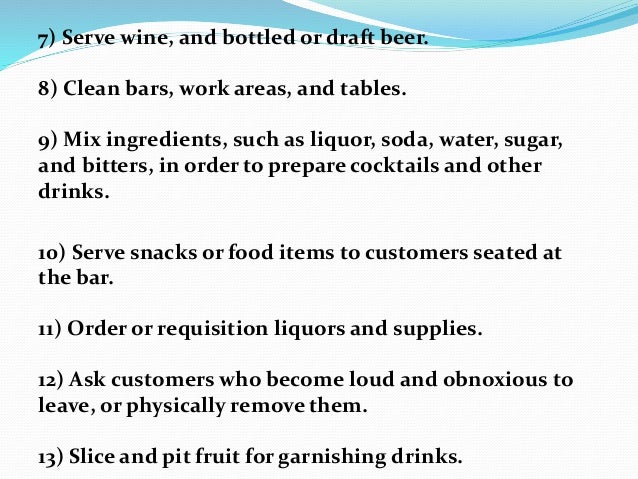

Most states require workers who serve alcoholic beverages to be at least 18 years old. Some bartenders gain experience in other jobs or occupations. They typically learn their skills through on-the-job training that lasts a few weeks. They also must monitor customers for intoxication, determine when to deny service and, in some cases, arrange for safe transportation.īartenders should be friendly, tactful, and attentive when dealing with customers.īartenders typically do not need formal education credentials to enter the occupation, although some employers require or prefer for candidates to have a high school diploma. Bartenders usually are responsible for stocking and maintaining an inventory of liquor, mixers, and other bar supplies.īartenders may collect payment from customers after each drink is served or open a tab for a customer and collect payment when closing it at the end of service. They also wash glassware and utensils and serve food to customers who eat at the bar. In addition to mixing and serving drinks, bartenders stock and prepare beverage garnishes and maintain ice, glasses, and other bar supplies. They should be personable with customers at the bar and also work well with waiters and waitresses and kitchen staff to ensure prompt service. When measuring and pouring beverages, they must avoid spillage or overpouring.

Bartenders must know a wide range of drink recipes and be able to mix drinks quickly.
BAR 1521 BARTENDER DUTIES HOW TO
How to Become a Bartenderīartenders typically do not need formal education credentials to enter the occupation. Part-time work is common, and schedules may vary. They often work late evenings, on weekends, and on holidays. During busy hours, they are under pressure to serve customers quickly and efficiently.

Work Environmentīartenders work at restaurants, hotels, and other food service and drinking establishments.

Quick Facts: Bartendersīartenders mix drinks and serve them directly to customers or through wait staff. Please enable javascript to play this video.


 0 kommentar(er)
0 kommentar(er)
